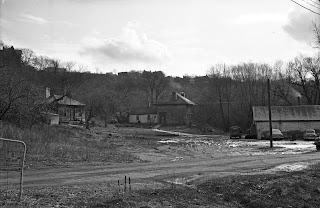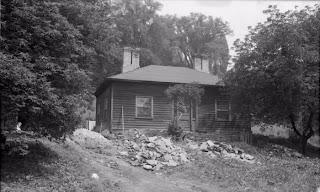Thanks to the Don Valley Art Club and its many noble antecedents, Todmorden Mills has been well-documented in art, especially oil and watercolours.
I was very interested in one oil painting I found in the Toronto Reference Library's digital archive: by D.C. Grose, it seemed to depict Todmorden's paper mill seen from upriver, perhaps from the intake of the original mill race, and the digital file labelled it: Taylor Bros. Mill on the Don River" by D.C. Grouse, 1860
 |
| Todmorden's mill building, c.1810 or 1860? |
[Todmorden] but there are no buildings beyond it on the hill, and there should be barns."
Well, today I went down to the Toronto Reference Library. The extraordinary staff there helped me locate the item. Turns out its inscription says "1810". Perhaps the photograph was from 1860, or perhaps someone attributed it to that date because they thought they were looking at the Taylor Lower Mill. But in 1810 this building was grist and saw mill, with a single race, and likely no barns behind it.The head race seems at an odd angle for Tod, also, according to maps from the period.
A little research points to a deeper mystery: David Charles Grose was born in 1838, and was painting in the 1860s. Did he take some artistic licence with the subject, and 'back date' the view, or is this a painting of another mill, that resembles Todmorden?



